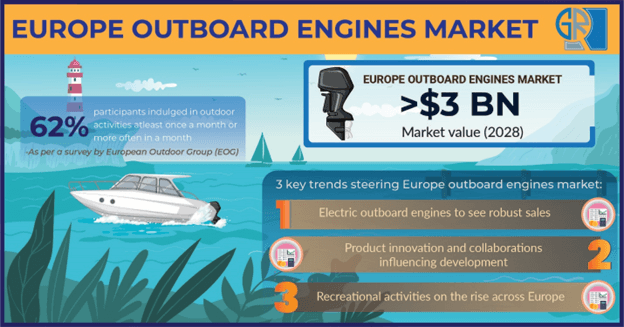Over the years, recreational activities and tourism have fueled the Europe outboard engines market forecast. A growth in the demand for small and medium-powered boats for transportation and outdoor boating is observed. The COVID-19 pandemic disrupted the industry as mobility was restricted throughout the region.
Stringent measures affected the travel and tourism industry affecting watersports and recreational activities. The manufacturing of boats was also halted. However, with the reduction in the spread of the virus, the restrictions have been lifted and people have started to travel more.
Reportedly, Europe outboard engines industry share is expected to reach over USD 3 billion by 2028. Below are some of the trends supporting market development in countries such as Germany, UK, Norway, Italy, and France, among others.

- Electric outboard engines to see robust sales
Electric-powered outboard motors are the next-generation engines as they are cleaner and nearly maintenance-free. The threat of polluting the water bodies and the environment can be avoided using these boats. These engines are gaining traction as they can be used on a variety of boats like sailor boats, fishing boats, commercial boats, and much more. In the coming years, this segment is expected to gain more traction attributed to the focus of companies on reducing their carbon footprint.
A few months ago, Torqeedo, an industry leader, collaborated with Proton Motor Fuel Cell GmbH. The objective of this collab is for the company’s existing Deep Blue battery-electric drive systems to get the hydrogen fuel cell charging. This way, the motor is cost-efficient, range limitations can be overcome, it can be fueled faster, and so much more.
- Product innovation and collaborations influencing development:
Market leaders in Europe outboard engines industry are development products to introduce some new additions. Suzuki Motor Corporation has plans to launch a microplastic collector that will be attached to the boat motors. Four of its popular outboard engines are going to be fitted with this device. The device can collect plastic waste on or near the water surface while the engine is running.
Citing another instance, Polestar has signed a multi-year agreement with Swedish company Candela, to supply batteries and charging systems for its electric speed boats. Candela is a startup that is working to electrify leisure boats and water taxis. Europe outboard engines market is predicted to benefit from the growing focus on sustainability over the upcoming years.
- Recreational activities on the rise across Europe:
As COVID-19 spread has slowed down, studies show that people are willing to travel more now compared to pre-pandemic levels. A survey conducted by the European Outdoor Group (EOG) showed that nearly 62% of the participants were indulging in outdoor activities at least once or more often in a month.
It is understood that Europe’s tourism segment will prosper in the years to come. As recreational boating is also a part of this segment, it is expected that outboard engines deployment will expand from rising number of river tours and trips. Outdoor activities in Greece, Italy, Netherlands are surging owing to the increasing number of tourists. The travel and tourism industry of the region is, undoubtedly, a major contributor to the industry forecast.
Some of the eminent solution providers in the Europe outboard engines industry are DEUTZ AG, Yamaha Motor Co., Ltd., Marine Tech, SECO GmbH, Honda Motor Co., Ltd., E.P. Barrus Ltd., Selva S.p.A., and Vector Outboards. The commercial and military applications of boating engines could bring in new growth opportunities for manufacturers, as defense expenditure and the demand for aquaculture & seafood increases. Emergence of innovative engines that are more fuel efficient and help countries meet their carbon reduction goals will also define the market trends over the coming years.


